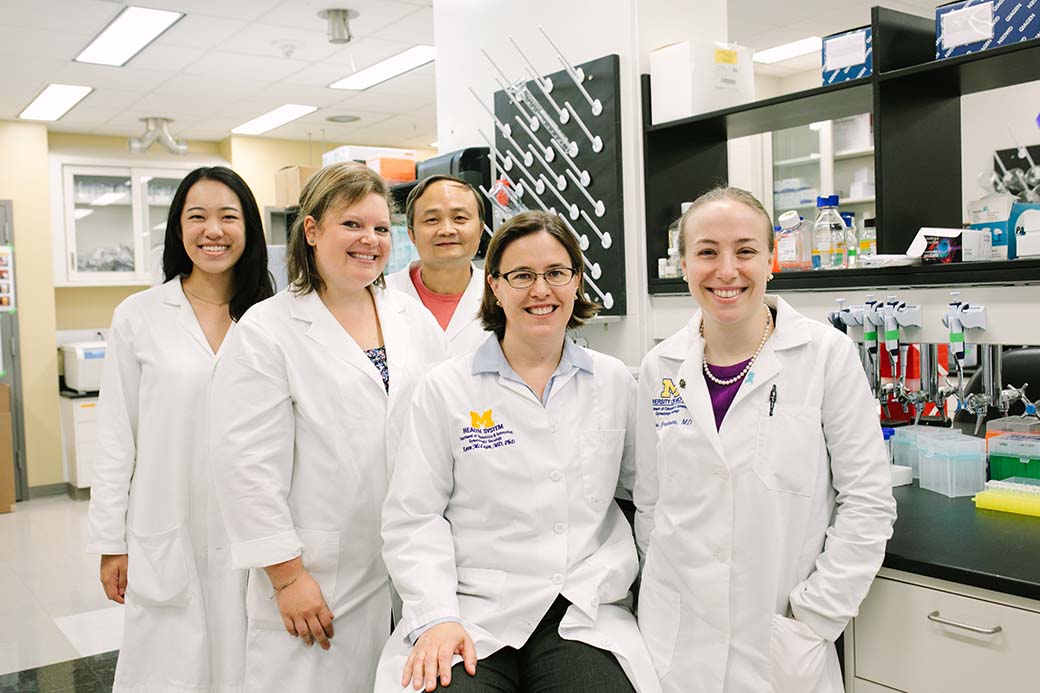Ovarian Cancer
Leukemia Inhibitory Factor and Interleukin-6: Functioning in Parallel to Promote Ovarian Cancer Growth



Posted December 15, 2021
Karen McLean, M.D., Ph.D., University of Michigan
 Dr. Karen McLean (center) and her lab group
Dr. Karen McLean (center) and her lab group
Ovarian cancer is the fifth leading cause of cancer-related deaths in women in the United States, and with about a 50% 5-year survival rate, it is crucial to develop new treatment strategies that reduce recurrence.1,2 Cancer-associated mesenchymal stem cells (CA-MSC) are specialized cells in the tumor microenvironment adjacent to cancer cells that send signals to promote cancer growth and chemotherapy resistance.3 Previous research has demonstrated that in CA-MSCs, both interleukin-6 (IL-6) and leukemia inhibitory factor (LIF), signaling components involved in the activation of the Janus/signal transducer and activator of transcription 3 (JAK/STAT3) pathway, are both upregulated. The ovarian cancer research community has been studying the impact of blocking the JAK/STAT pathway due to its signaling role in tumorigenesis. With a Fiscal Year 2014 Ovarian Cancer Research Program Ovarian Cancer Academy Award - Early-Career Investigator Award, Dr. Karen McLean, a physician scientist bridging the gap from bench to bedside, sought to determine the ability of blocking IL-6 and LIF to inhibit the growth of anti-IL6 resistant ovarian cancer cells.
As described in Oncogene, Dr. McLean and her group began by investigating the effects of LIF signaling from CA-MSC and the redundancy of IL-6 and LIF in activating STAT3 in ovarian cancer cells. They found that CA-MSC factors induced STAT3 activation that is blocked by targeting downstream signaling proteins shared by LIF and IL-6. Results from sphere assays and flow cytometry experiments showed that both IL-6 and LIF increased the percentage of ovarian cancer stem-like cells through STAT3 signaling. LIF still promoted tumor sphere growth when IL-6 was blocked, and IL-6 still promoted tumor sphere growth when LIF was blocked, demonstrating the redundancy of the two cytokines. This redundancy suggested that targeting either IL-6 or LIF alone may be less effective than targeting both cytokines. Dr. McLean found that cancer growth promoting effects of CA-MSC in an ovarian cancer mouse model was inhibited to a much greater extent by using both anti-IL-6 and anti-LIF antibodies together or with the JAK2 inhibitor ruxolitinib (already approved by the Food and Drug Administration for hematological diseases) rather than treatment with the anti-IL-6 or anti-LIF antibodies alone. These results suggest that blocking both IL-6 and LIF in combination is more effective in slowing the growth of ovarian cancer cells than just blocking one of these signaling factors. Finally, her team demonstrated that ruxolitinib can slow ovarian cancer growth in mice with an intact immune system, again by decreasing STAT3 activation.
Overall, Dr. McLean's research team suggests that the redundant JAK/STAT pathway activation by both LIF and IL-6 cytokines may account for the lack of therapeutic efficacy of IL-6 blockade alone. Therefore, to achieve the greatest therapeutic effect, shared downstream signaling components of both IL-6 and LIF need to be targeted in order to reduce the growth of ovarian cancer cells. The findings from this study on IL-6 and LIF signaling will potentially impact therapeutic options for patients and allow development of new treatment strategies to overcome resistance. Dr. McLean continues to study the importance of tumor microenvironment signaling, including studies into the relationship between cytokine and estrogen signaling.
Publication:
McLean K, Tan L, Bolland DE, et al. 2019. Leukemia inhibitory factor functions in parallel with interleukin-6 to promote ovarian cancer growth. Oncogene. 38(9):1576-1584.
References:
1Ghoneum A, Afify H, Salih Z, et al. 2018. Role of tumor microenvironment in ovarian cancer pathobiology. Oncotarget. 9:22832-22849.
2American Cancer Society (wwww.cancer.org).
3McLean K, Gong Y, Choi Y, et al. 2011. Human ovarian carcinoma-associated mesenchymal stem cells regulate cancer stem cells and tumorigenesis via altered BMP production. Journal of Clinical Investigation. 121:3206-3219.
Links:
Last updated Friday, December 13, 2024














